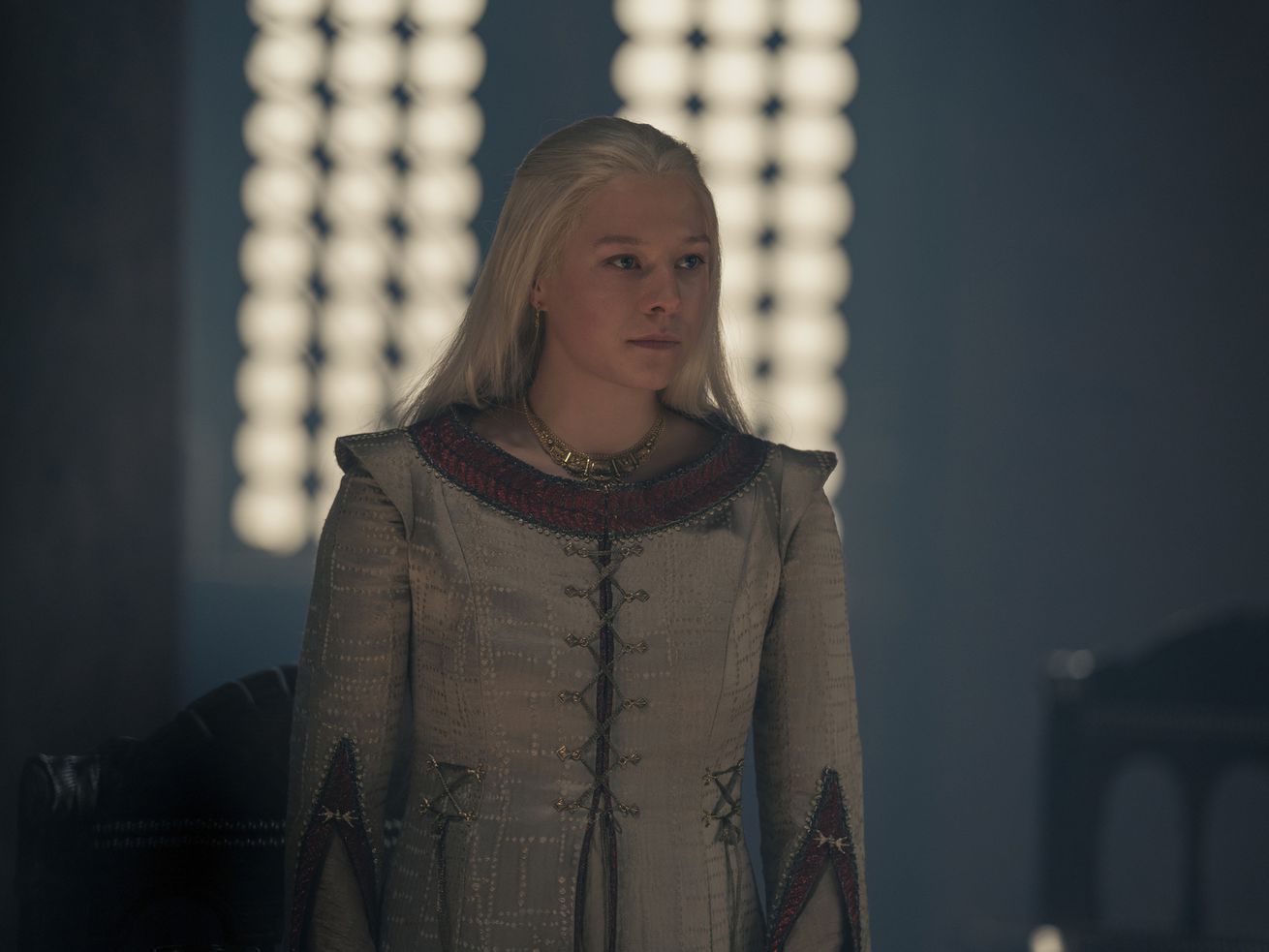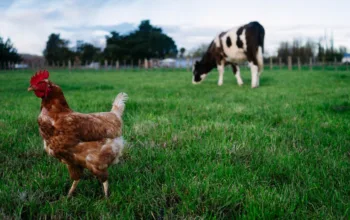If childbirth is a battle, then Targaryen mothers are war veterans.
Prior to the debut of House of the Dragon, co-showrunner Miguel Sapochnik told the Hollywood Reporter that the season would feature a number of childbirth scenes — all of which the creative team approached like “battles.”
By the time we reach episode six, “The Princess and the Queen,” said princess and said queen have each given birth at least three times. According to the show’s logic, then, Rhaenyra and Alicent are both war veterans.
Note: This article contains spoilers for House of the Dragon, Episode 6, “The Princess and the Queen.”
So far, House of the Dragon has played out less like a four-act opera than the overture before the show. We’ve gotten micro versions of the conflicts that will eventually erupt into full-blown civil war between our two main factions. We’ve greeted a steady stream of characters and learned all their secrets, foibles, and motivations as they carefully find their places on the great chess board. Many of them, especially in this episode, rotate into position only to be immediately dispatched through disgrace or death. The intermittent bursts of shocking violence have so far devastated only peripheral characters, never Rhaenyra or Alicent directly.
The sole exception to this rule involves the type of violence that’s rarely framed as violence: childbirth. One of those brutal childbirth scenes formed the bloody core of the show’s first episode, with the death of Rhaenyra’s mother casting a long shadow over the Red Keep. Now, as the season makes its biggest time jump yet, we get a harrowing look at two more of those birth scenes — one with an outcome that suggests the show’s family ties are, themselves, acts of violence, and that each point on the dense Targaryen family tree is, in truth, a battle scar.
The magnificent Targaryens
The episode starts with a major skip some 10–15 years into the future and functions as a midpoint reset for the season. Accordingly, the show replaces its younger actors with adults. Fresh-faced Milly Alcock, who played a defiant but naive young Rhaenyra, becomes Emma D’Arcy, whose Rhaenyra is hardened and iron-willed but also perpetually exhausted. As Alicent, the wide-eyed, petrified Emily Carey, having gained some sentience through last week’s green dress maneuver, transitions seamlessly into the still-wide-eyed but constantly calculating, now permanently paranoid Olivia Cooke. Like father, like daughter.
During the time we’ve skipped ahead, the major players of the Dance of Dragons (the coming civil war) have arrived on scene. (We go into more detail on the newly updated Targaryen family tree.) In one corner, you’ve got the children of Alicent and Viserys: Aegon (Ty Tennant), a spoiled but typical teenage boy, his reticent younger sister Helaena (Evie Allen), and their weak but determined younger brother Aemond (Leo Ashton). The Targaryen children have grown up in a bubble of privilege that few things have managed to puncture. In a truly hilarious moment, Alicent tries to impress upon Aegon that his stepsister is going to claim the throne, and he mumbles, “So?” leaving her to spell out for him in capital letters the plot of this show.
In the other corner are the children of Rhaenyra and her illicit lover, Harwin Strong (Ryan Corr): Jacaerys “Jace” Velaryon (Leo Hart), Lucerys “Luke” Velaryon (Harvey Sadler), and Joffrey Velaryon — whose birth we witness in a grueling opening scene. The boys all bear the name Velaryon despite being very obviously the offspring of Rhaenyra and her brown-haired beau, not Rhaenyra and her husband Laenor. (To give you an idea of how complicated the Velaryon family bonds are, Laenor insists on naming the newborn Joffrey after his own lost lover, Joffrey Lonmouth — the man who met a horrific end at the hands of Ser Criston Cole in the previous episode, breaking Laenor’s heart in the process.)
The illegitimacy of the three Velaryon boys — don’t call them “Strongs”! — already looms over their childhoods and turns every conversation between Viserys (Paddy Considine) and his court into a series of entrapments. So far, the king has refused to acknowledge the reality in front of him: The questionable parentage of Rhaenyra’s children further undermines her claim to the throne. The birth of Rhaenyra’s third son, once again clearly not a black man with blond dreads, only increases the tension between Rhaenyra and Alicent. By the end of the episode, the encroaching monster of succession has started tangling its claws around each of their children as well.
But at what cost? The dual scenes of childbirth that feature prominently in this episode hint that House of the Dragon might be engaged in deconstructing the way Game of Thrones handled the question of power — by viscerally returning us to the roots of all power in Westeros: motherhood.
Every birth a battle
We’ve previously discussed the impact of House of the Dragon’s opening episode on our real-world understanding of childbirth in a post-Roe world; that is, such a world is brutal, unforgiving, dehumanizing, and arguably murderous. The two labor scenes in “The Princess and the Queen” each ask an inevitable follow-up question: What toll does giving birth in such a barbaric world exact on the women who have to exist in it?
And each scene gives us a dramatically different, but carefully linked, answer.
The opening scene of the episode is an excruciating, drawn-out birth scene, made all the more jarring because we’re also adjusting to our first sight of grown-up Rhaenyra. The camera lingers on her face throughout the ordeal as she struggles to successfully deliver her child. At last, she pops the baby out, and there’s a instant of respite for her and for us. But hardly has Rhaenyra collapsed back onto the bed than she gets a summons from the queen.
Alicent wants to see the newborn child herself, immediately. It’s a brazen form of rank-pulling and passive-aggression that tells us all we need to know about the direction Alicent’s character has evolved in the years since we last saw her. The camera darts over to Rhaenyra’s face, now marked with palpable fear: She doesn’t, perhaps can’t, trust Alicent to be alone with her vulnerable infant.
Rhaenyra decides to call Alicent’s bluff: Though she can barely stand, she staggers to her feet, still passing afterbirth, and takes Joffrey to Alicent herself. A confused Laenor supports her as she limps through the castle, doing his best to crack jokes. At one point, he comically — but half-seriously — compares her unbearably painful ordeal to getting shot in the shoulder with a crossbow.
That he’s joking about this all while she’s still suffering, still bleeding, even, underscores the disconnect between the demands placed on the women of the court and the reality of carrying them out. The whole moment functions as a microcosmic illustration of Rhaenyra’s position in court: Even as the heir apparent, she’s expected mostly to be a whole, healthy incubator. Once she’s delivered her children, however, her role can be supplanted. A prior claim on her sons exists, and it’s not the claim of family or honor or any loftier ideal; it’s the claim of the court itself.
Rhaenyra, always insistent upon exerting whatever agency she has in a situation with no good options, chooses to take her subservience to that claim and use it to her advantage: While trekking through the castle she horrifies and impresses the court in equal measure. She is strong enough, barely, to make the long walk to see the queen, who makes a show of being duly astonished and concerned for her health. But the performance has its limits: Rhaenyra protects her child and scores a point against Alicent, but she knows she can’t protect him forever.
Contrast this long, exhausting scene of labor and more labor with the brief and weirdly unintelligible birthing scene that comes near the end of the ep. Laena Velaryon (Nanna Blondell) has married Daemon (Matt Smith), who’s somehow managed to keep from murdering her long enough for them to raise two teenage twins, Rhaena and Baela. What we do see of Laena in this episode is a noble, proud Velaryon heir who’s riding the biggest dragon in the realm — Vhagar, once ridden by Aegon the Conqueror himself. She’s clearly come a long way from the halting child whose parents forced her to try and woo the 50-something King Viserys.
Yet none of Laena’s polish nor promise can save her from the terrible obligation of childbirth. While in labor with what would have been Daemon’s third child, Laena experiences complications that apparently stymie the physician. He declares that he’s done all he can do, the child won’t come. Echoing the choice Viserys faced in the first episode, the doctor offers to cut Laena’s womb in order to try to save the child — asking Daemon, of course, not Laena, who’s in agony in the background, unable to complete the delivery. Daemon refuses with a slight headshake, presumably signaling that they should simply let nature take its course.
The scene then cuts to a shot of Laena, staggering alone down the beach to where Vhagar rests on the shore. Her dress is bloody but she’s still visibly pregnant. It’s unclear if Laena has miscarried, but signs point to yes; given the choice she makes next, the alternative is almost too horrible to contemplate. Laena, sobbing, orders Vhagar to immolate her. When the dragon resists, she begs him, and Vhagar sorrowfully burns her alive in a burst of flame while Daemon watches in stunned silence.
What’s the show doing, burning through all these characters?
On its face, this entire sequence feels mishandled: It’s too brief, the events are confusing, and we’ve known Laena for too short a time for such an excruciating death scene to meaningfully impact our understanding of the show. For that matter, she isn’t the only character we’ve barely met who gets burned alive in this episode. (Harwin Strong, Lionel Strong, we hardly knew ye.) Throughout its middle episodes, HotD seems to be introducing us to new potential chess pieces, only to knock them off the board before the match has even begun. Is that the “point” of Laena Velaryon? Was she put into place only to be rendered expendable?
I think yes and no. While it’s true we’ve only seen her for a few moments throughout the show so far, we know several crucial things about her life — beginning and ending with her identity as a Velaryon. She seems to have wanted to wed Daemon, true, marriage itself was an inevitability, and she certainly never had the option to say no to motherhood. The psychological impact of being nearly trafficked into marriage at the age of 12, of having her wings clipped upon the advent of motherhood, of being confined into a static and limited role as wife and mother rather than powerful clan leader and noble dragonrider — she carries all of that with her down to the beach. Interestingly, in Fire and Blood, Martin’s version of this scene is different: He suggests, through the veil of legend and lore, that Laena walked down to the beach to attempt to ride her beloved dragon one last time, even while dying. The show’s version of Laena has more self-awareness and less hope.
These childbirth scenes have drastically different outcomes, but both depict the act of childbirth in Westeros as a fundamentally torturous form of conscripted labor — “labor” used here in both senses. The duty of women in the Targaryen clan, above all else, is to give birth: to increase potential heirs so that the line of succession can continue and extend the greatness of the Targaryen dynasty. The family lineage of the Targaryen clan is its most important asset, but every point along that tree is the result of a woman risking her life and putting herself through untold hours of pain and physical toil, not to mention the many miscarriages she might have had in addition.
At our point on the family tree, both Rhaenyra and Laena, even while debilitated from the effort and exhaustion of labor, remain defiant. Rhaenyra chooses to stagger through the castle, weaponizing her weakness and turning it into a show of strength. Laena chooses, on her own terms, to stop playing the game. She asserts her hold over the one thing she can still command: her dragon.
Inevitably, the grim nature of both birth scenes leaves us questioning the reason for all of this. Is securing all those points on the Targ tree even worth it? In this episode, we repeatedly see family bonds tested and proven to be thin as cobwebs. Alicent has to remind Aegon not to bully his own brother; Larys Strong burns his own father and brother alive for clout. Rhaenyra’s attempt to secure a lasting peace with Alicent through marriage fails completely due to her stepmother’s distrust. Being born into the Targaryen clan, or adjacent to it, might secure one a degree of power, but it also puts them at greater risk of being betrayed by those closest to them.
If that’s the best fate a woman can secure for her offspring in exchange for the excruciating pain of childbirth, it hardly seems worth the hardship. No matter, the choice isn’t hers; she has to avoid the chopping block herself, after all. It might be better to think of the Targaryen family tree less like a tree, then, and more like a vast machine, with cogs instead of people — a Modern Times for medieval times. The more cogs, the more an inherently violent system keeps functioning as intended, running on the strength and sacrifices of the women it immolates.
Author: Aja Romano
Read More



